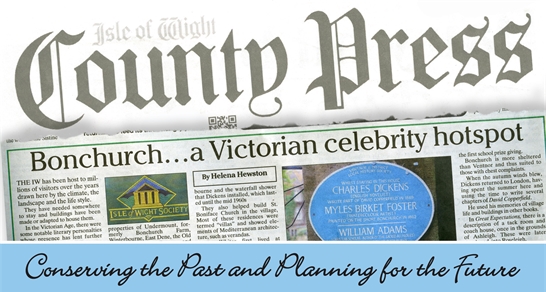June 2017
The Isle of Wight has been host to millions of visitors over the years drawn here by the climate, the landscape and the life style. They have needed somewhere to stay and buildings have been made or adapted to house them. In the Victorian Age there were some notable literary personalties whose presence has lent further attraction to the Island. Some properties stand out, such as Tennyson's Farringford and later JB Priestly's Brook Hill House, because of their architectural style while others could be described as “in the vernacular” blending in with the local scene.
It is useful to look at Brannon prints to start to imagine what life was like before made up roads and central heating. One such print by P Brannon in 1843 depicts Bonchurch with the recognisable properties of Undermount, formally Bonchurch Farm, Winterbourne, East Dene, the Old Church, Cliff Dene and Bonchurch Hotel. These buildings can be associated with the names of Charles Dickens and Algernon Swinburne. Not depicted are other haunts of the literary set and their supporters, the chief of which was the Reverend James White. It was he who began extensive building in the village using Daniel and Jonathon Day as builders. Around 20 houses were built in two years. They reconstructed Winterbourne, and the waterfall shower that Dickens installed which lasted until the mid 1960s They also helped build St. Boniface Church in the village, Most of these residences were termed “villas” and showed elements of Mediterran architecture such as verandas.
The Whites first lived at Uppermount. Many present day Islanders would have known this as The Peacock Vane. They moved to Woodlynch where they entertained Tennyson, (poet) Carlyle, Thackery, Dickens, Doyle, Lemon(writers) and Leech, (cartoonist for Punch) among others. Leech resided at Hill Cottage, now Hillside Cottage near the Old Bonchurch Hotel.
The influx of London's second home dwellers either buying or renting, included not just writers, but also churchmen, artists and the fashionable elite.
Modernisation of the Anglican Church through The Oxford Movement meant attendances increased to such as extent a larger building was needed. The old church was under threat of demolition but White had a piece of land called Marepool or Mackett's Field and a church, graveyard and school were built higher up the village. Captain Swinburne contributed £600 to the venture. Dickens officiated at the first school prize giving.
Bonchurch is more shelted than Ventnor and thus suited those with chest complaints. When the autumn winds blew Charles Dickens returned to London, having spent the summer here and using the time to write several chapters of David Copperfield. He used his memories of village life and buildings in other books. In Great Expectations there is a description of a tack room and coach house, once in the grounds of Ashleigh. These were later developed into Roseleigh.
When future Islanders look back to our time, in all probability, they will be able to point to musicians and entertainers, as key figures in English culture, as supporting the Island character and style . There are some very modern architectural gems waiting their turn to have a Blue Plaque attached to them.
[Go Back]

